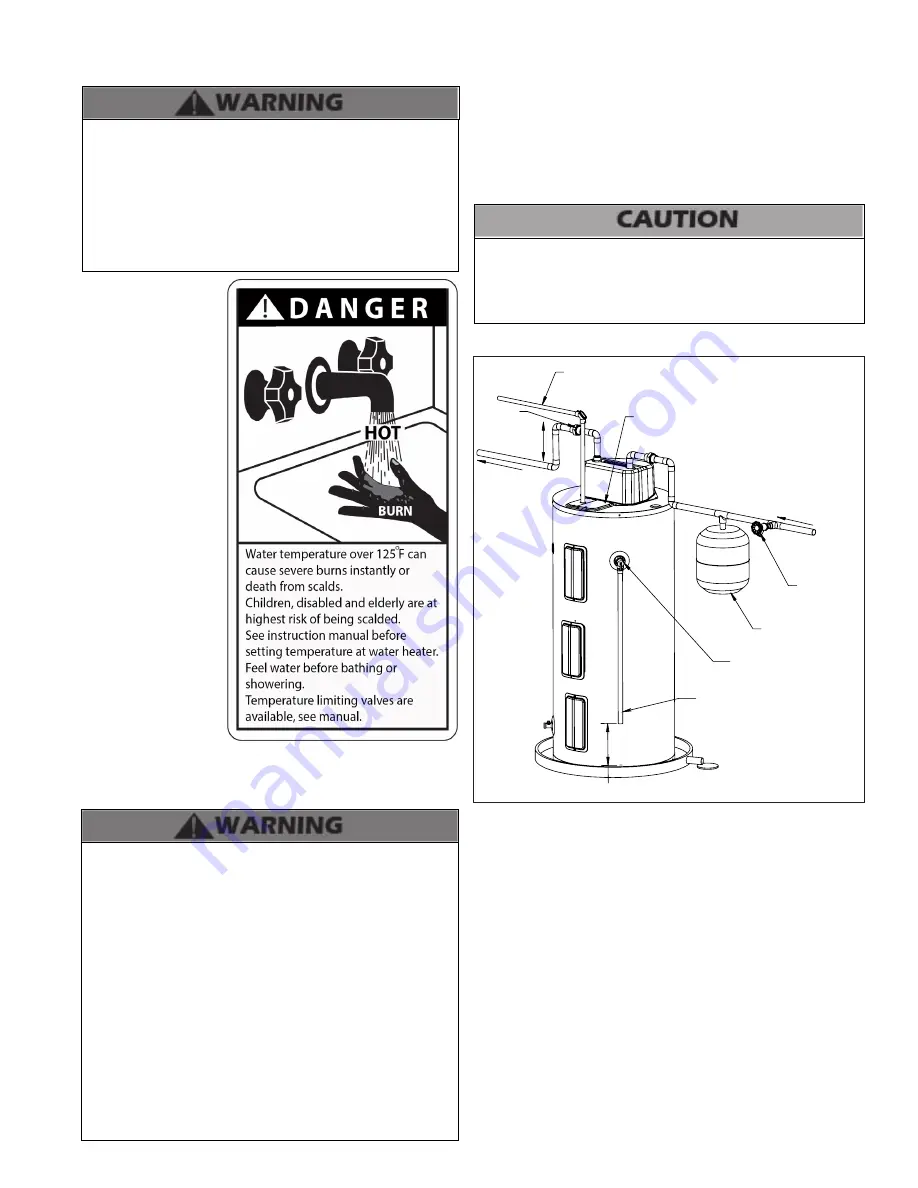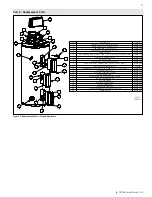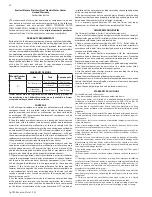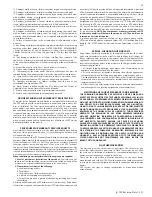
lp-790 Revision Date 1.3.22
9
F. Scalding
Mixing valves can reduce but do not eliminate the risk of scalding.
To avoid scalding:
•
Set the water heater set point temperature as low as
possible to meet installation requirements.
•
Feel water before bathing or showering.
•
Use the mixing valve in accordance with the instructions
provided by the manufacturer.
Failure to follow these instructions could result in property
damage, severe personal injury, or death due to scalds.
This water heater can
deliver scalding water.
Be careful whenever
using hot water to
avoid scalding injury.
Certain appliances
such as dishwashers
and automatic clothes
washers may require
increased water
temperatures. By setting
the thermostat on
this heater to obtain
the increased water
temperature required by
these appliances you may
create the potential for
scald injury.
To protect against injury,
a mixing valve has been
installed in the water
heater. This valve will
reduce point of use
discharge temperatures
by mixing cold and hot
water in branch supply
lines.
Table 1 details the
relationship of water
temperature and time with regard to scald injury and may be used
as a guide in determining the safest water temperature for your
applications.
After installation, water heater outlet temperature MUST BE
checked with a thermometer at a hot water outlet fixture.
•
Finish installing the water heater. Ensure it is properly
piped, powered, and full of water (purged of air).
•
Power the water heater. Wait for the water heater to satisfy
the thermostat set point and has finished heating.
•
Choose the hot water outlet fixture nearest to the water
heater.
•
Open the outlet. Check the outlet temperature with a
thermometer.
NOTE:
DO NOT check the outlet temperature
with your hand.
•
Make a note of the temperature measured by the
thermometer when it stops rising.
NOTE:
It may take some
time for cooler water to clear the system.
•
Follow the instructions in this manual if thermostat or
mixing valve need adjustment.
Failure follow these instructions could result in property damage,
severe personal injury, or death due to scalds.
• Make certain that the drain valve is completely closed.
• Open the shut-off valve in the cold water supply line.
• Open the hot water faucets to allow air to vent from the heater
and piping.
• Allow sufficient time for the heater to completely fill with water.
• Verify elements are installed correctly. Check for leaks.
G. Filling the Heater
When filling the water heater, open a hot water tap to release air in
the tank and piping. The tank must be full of water before the heater
is turned on. Failure to ensure the water heater is full before turning
it on could result in damage to the water heater and other property
damages. Such damages ARE NOT covered by water heater warranty.
H. Applications
6" AIR GAP
TO ELECTRICAL
DISTRIBUTION PANEL
UNION
TEMP/PRESSURE
RELLIEF VALVE
THERMAL EXPANSION
TANK
ELECTRICAL JUNCTION
BOX
SHUT-OFF
VALVE
HOT WATER
OUTLET TO
FIXTURES
COLD WATER
INLET
RELIEF VALVE DISCHARGE
LINE TO SUITABLE OPEN DRAIN
HEAT TRAP
6" MINIMUM
LP-790-D
10/06/21
Figure 4 - Piping Detail - NOTE: Drawing is meant to demonstrate system
piping concept. Heat traps are optional.
PIPING NOTES:
1. Minimum pipe size should match connection size. Upsize pipe
accordingly if greater flow is required.
2. A thermal expansion tank suitable for potable water must be
sized and installed within this piping system between the backflow
preventer and the cold water inlet.
3. All circulators should have an integral flow check.
4. Drains and check valve between unit and storage tank will assist in
purging air from system.
5. These drawings are meant to demonstrate system piping only. The
installer is responsible for all equipment and detailing required by
local codes. In Massachusetts, you must install a vacuum relief valve
per 248 CMR.
6. Mixing valve application is optional, but recommended to help
prevent scalding. See Part 3 for more information.





































